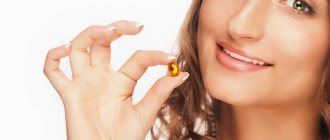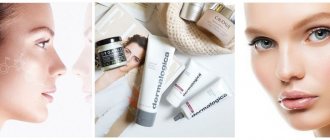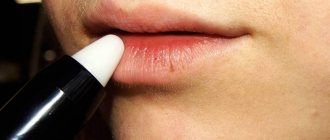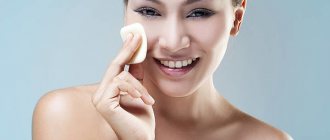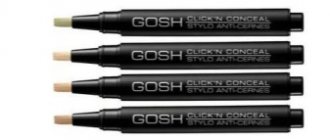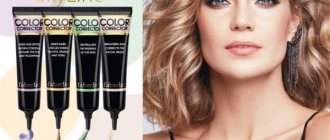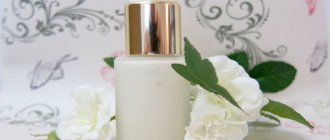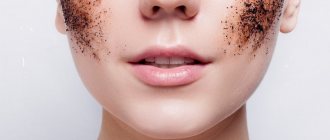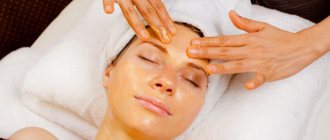11.12.2020
Retinol is a form of vitamin A, but this is what people call vitamin A in principle. For convenience, we will do this too. Retinol is a real star in cosmetology. Many people have heard that it is effective for almost all skin problems, but it must be used carefully. Let's find out all the details: why you need retinol for the face.
If we talk about retinol as a form of vitamin A, then this is the most easily absorbed form for skin cells. It is pure retinoic acid. There are other forms used in facial cosmetology: retinol palmitate, retinol acetate. They must first be transformed in the body, and only then act on cells.
Note: natural forms of vitamin A are used in cosmetology, and synthetic forms are used in pharmacology.
Why use retinol for facial skin?
In one sentence, retinol stimulates cells, accelerating their renewal process. That is, it heals the skin as a whole. From here we get a wide range of actions:
- The work of the sebaceous glands improves, the pores narrow;
- Wrinkles become less pronounced, and small ones are completely smoothed out;
- Pigment spots are lightened;
- Rashes are destroyed, and traces of deep pimples and acne disappear;
- The skin becomes firmer and more elastic – the production of appropriate proteins, collagen and elastin is stimulated;
- The moisture level in the cells is maintained at normal levels. This is done by retinol stimulating the cells responsible for the production of hyaluronic acid;
- Dead cells are removed. These cells are not visible to the naked eye, but they are there even if the skin appears smooth. Over time, natural skin renewal slows down, and retinol helps bring its rate closer to normal.
Thus, retinol is used to treat problematic facial skin, rejuvenate and moisturize. However, the use of this substance has its own nuances and limitations. Cosmetologists do not recommend doing anything on your own when choosing the dosage. There are also different forms of vitamin A in cosmetology - we will also consider this issue.
Skin aging is a continuous process that affects the appearance and function of the skin. The course of this process is determined by internal factors (genetic) and external (state of the environment and lifestyle) [1, 2]. Exposure of skin cells to reactive oxygen species, cellular stress, slowdown of metabolism in cells and tissues reduces skin regeneration and repair. Typical signs of skin aging are dryness and flaking, hyperkeratosis, decreased immune and protective functions of the skin and, as a consequence, the appearance of age-related pigmentation and neoplasms [3, 4]. Scientific research in recent years shows that topical retinoids are strategically important antiage
-therapy, prevention of photoaging and treatment of photodamage [5, 6].
Retinoids are structural analogs of vitamin A. Retinoids have been successfully used in clinical practice for more than 60 years. During this time, three generations of retinoids appeared, and the number of drugs containing them exceeded 2500. Today in dermatology there are more than 125 pathological conditions for which the prescription of retinoids can be effective.
Retinol is one of the most famous representatives of the 1st generation of retinoids. Preparations based on it are in the arsenal of every Russian dermatologist. Although multicenter studies have not been conducted to evaluate the effectiveness of retinol, there are many studies that evaluate the biological and clinical effectiveness of this substance [7, 8].
Commonly known as vitamin A, retinol belongs to the family of endogenous natural retinoids and is a precursor to retinaldehyde and trans-retinoic acid. Despite the fact that retinol is a precursor of retinoic acid, in foreign practice since 1984 it has been predominantly used in the production of cosmetic products and over-the-counter products [9].
However, it should be borne in mind that in proper dosages, retinol has pronounced biological activity and has a significant clinical effect, especially in the correction of pathological conditions directly or indirectly associated with exposure to ultraviolet radiation. A study (R. Kafi et al., 2007) [10] demonstrated that the use of retinol in older people significantly improved the appearance of the skin of areas of the body not protected from exposure to sunlight. A. Rawlings et al. [11] in a randomized study conducted over 12 weeks, confirmed the effectiveness of retinol palmitate for the prevention of chrono- and photoaging compared to the control group ( p
<0,001).
Considering the minimal side effects of retinol, its use may become one of the priority options for solving such a problem as the tactics of managing “aged” patients with various skin pathologies. Older people are characterized by dry and flaky skin: as they age, skin dryness increases and oiliness decreases. These changes may be partly due to age-related impairments in barrier function: a decrease in lipid content, as well as filaggrin in the epithelium, which ultimately increases transepidermal fluid loss (TEFL) [12]. Almost all forms of hand eczema in older people begin with a violation of the stratum corneum barrier, which is accompanied by TPE [13]. In “aged” patients, thinning of the epidermis is realized mainly due to a decrease in the thickness of the spinous layer and partial or complete disappearance of the granular layer. In old age, the stratum spinosum may consist of two rows of cells. In the epidermis, the number of Langerhans cells decreases; in those that remain, dystrophic changes are noted (clearing of the matrix, cytoplasm), and sometimes partial cell lysis, which leads to a sharp decrease in the protective properties of the epidermis.
Retinoids are well known for their ability to influence a number of cellular processes, such as cell growth and differentiation, apoptosis and embryonic development, and immunomodulation. Many of the effects, including retinol, are explained by the result of their interaction with specific receptors for retinoic acid and the existence of retinoid-binding proteins (Fig. 1)
[14].
Figure 1. Interaction of retinol with specific retinoic acid receptors and retinoid-binding proteins.
Thus, when using retinol with antioxidants (vitamins C, E, zinc), an improvement in the barrier function of the skin and an increase in the activity of immune system cells were noted [15, 16]. In their study, J. Fluhr et al. [17] confirmed that the use of retinol for 2 weeks significantly reduces transepidermal water loss, which directly indicates an improvement in the barrier properties of the skin. Experimental results [18] have proven that the use of 1.6% retinol on normal human skin causes thickening of the epidermis and increases the expression of CRABP II and CRBP (retinoid-binding proteins) mRNA. Today it is known that UVR activates the expression of matrix metalloproteinase (MMP) genes. As a result, the formation of collagenase, gelatinase and stromelysin, MMP enzymes that destroy collagen, is activated [19-21]. The decrease in type I collagen content under the influence of UV irradiation is also explained by the activation of MMPs. More recently, it has been demonstrated that, in addition to the numerous mechanisms of action of retinoids, the anti-inflammatory effect of vitamin A derivatives is realized by suppressing the toll-like receptor system (TLR-2). Given the proinflammatory nature of UV-induced aging, it is possible that TLR-2 also mediates skin changes during aging. Since TLR-2 regulates MMP expression, it can be assumed that the effect of topical retinoids is partly realized through suppression of MMP expression due to inhibition of the TLR-2 system [22]. J. Varani et al. [23] studied the effects of topical application of 1% retinol in individuals aged 80 years and older ( n
=53) with characteristic age-related skin changes. The authors [23, 36] noted that the use of retinol for 7 days inhibited the activity of MMP, collagenase and gelatinase with a corresponding increase in collagen synthesis by fibroblasts in the tissue samples studied. S. Seité et al. [16] conducted two double-blind, placebo-controlled clinical trials in postmenopausal women. The results of external use of 0.04 and 0.07% retinol in combination with 3 and 3.5% vitamin C were assessed after 3 and 6 months. After 3 months, the main changes were recorded in the epidermis (the severity of hyperkeratosis decreased and the number of rows of the Malpighian layer increased). After 6 months, positive structural changes were noted in the dermoepidermal junction, the content of type I collagen increased, which led to a change in the ratio of collagen types I and III.
To date, it has been proven that retinol interacts with nuclear receptor systems (RARs) and during metabolism can be converted into tretinoin, which is a hormone [18]. Nuclear receptors RARs and RXRs belong to a large superfamily of nuclear hormone-sensitive receptors, which include receptors for steroids, thyroid hormones and vitamin D. Obviously, the interaction of these receptors is being actively studied in connection with the use of topical and systemic retinoids for the treatment of allergic dermatoses resistant to traditional treatment with topical glucocorticosteroids and UV therapy [24-26].
In our country, one of the external products that contain retinol is Redecil ointment. Redecil
- a new combined dermatotropic drug, which contains 0.5% retinol palmitate and 3% dioxomethyl-tetrahydropyrimidine (methyluracil) on an emulsion basis, was specially developed for the treatment of allergic skin diseases.
Indications for the use of Redecil
include eczema, neurodermatitis, and atopic dermatitis.
IN AND. Albanova et al. [27, 28] assessed the effectiveness of Redecil
in the treatment of atopic dermatitis and noted its anti-inflammatory and anti-allergenic properties, as well as its effect on the main skin symptoms.
Redecil
ointment reduced dryness by 30%, reduced swelling by 35%, skin lichenification by 50%, itching by 50%, and the incidence of concomitant skin infection by 50%, while other parameters remained at the same level.
Research results [29] showed that Redecil
stimulates the proliferation of epidermal cells and modifies the inflammatory process, activating the fibroblastic reaction of the dermis;
At the same time, the combination of intensive skin regeneration with the absence of manifestations of hyperkeratosis, noted during the study of the proposed dosage form, seems important. One of the notable molecular mechanisms of action of retinol is the increase in keratinocyte proliferation activity by triggering epidermal growth factor. This factor is involved in the healing of skin wounds, which is extremely important for elderly patients receiving chemotherapy [30]. Since Redecil
contains methyluracil (a structural analogue of the natural nucleotide - thymine), which is a known stimulator of regeneration and has anabolic, immunomodulatory and anti-inflammatory effects, the range of use of the ointment is significantly expanded
(Fig. 2)
[29, 31].
Figure 2. Effects of using Redecil ointment. Thus, the use of Redecil
in surgical practice has made it possible to optimize the timing of treatment, especially for burns and the treatment of purulent and infected wounds, to achieve earlier regeneration in trophic ulcers and faster healing [32].
It is believed that the effectiveness of retinol is 20 times weaker than tretinoin. However, it has been proven that retinol, used without an occlusive dressing, penetrates the skin more intensively than retinoic acid under the same conditions [12]. Thus, retinol at a concentration of 0.25% can be an effective treatment when applied to the skin. At this concentration, retinol does not irritate the skin, but at the same time induces cellular and molecular changes similar to those observed when 0.025% retinoic acid is applied to the skin. When retinol is applied at this concentration, histological and molecular changes are observed in the skin, similar to those when retinoic acid is applied [8]. Another important circumstance: when applying retinol ( Redecila
) the total level of retinoic acid in the body does not increase significantly [33].
In addition, Redecil
does not cause statistically significant changes in hemoglobin content, cellular composition of peripheral blood and other biochemical parameters reflecting the state of protein, lipid, carbohydrate and mineral metabolism [33]. This observation suggests that when applied topically, the absorption of retinol palmitate is minimal, due to which there is a fairly wide range of therapeutic effects and age range. Although retinol interacts with RARs and can be metabolized into tretinoin, erythema has rarely been reported with retinol [12, 34, 35].
Thus, based on literature data, we can conclude that retinol is an effective and relatively safe agent in the treatment of aging and photoaging of the skin. New drug for external use Redecil
has anti-inflammatory, antipruritic, softening and immunomodulatory effects, affects the reparative function of the skin.
Redecil
is easy to use, suitable for long-term use without reducing therapeutic activity and has virtually no side effects.
Pitfalls of retinol (vitamin A) for the face
Having talked about the magical benefits of retinol, it is necessary to immediately make a reservation about the dangers it poses. Of course, in case of incorrect and uncontrolled use:
- The appearance of red spots, swelling; peeling of the skin, all kinds of irritation. This is the first and most obvious sign that something has gone wrong. In case of any skin reactions similar to allergic ones, the use of retinol should be stopped immediately;
- Vitamin A tends to accumulate in the body - excess is not excreted, as is the case with many other active supplements. It accumulates in the liver, so before using retinol for the face, you need to take a liver test;
- Retinol is dangerous for the embryo, or rather, it simply kills it. Therefore, this substance is contraindicated during pregnancy. Moreover, you will need to carefully protect yourself for the first six months after stopping retinol;
- Retinol makes the skin more sensitive and receptive to sunlight. Moreover, vitamin A itself is destroyed by the sun. Therefore, it is imperative to use sunscreen along with retinol facial cosmetics. Otherwise, it will be at least useless, or worse, age spots will appear.
There are also contraindications to taking retinol:
- Liver diseases: cirrhosis, viral hepatitis;
- Pregnancy;
- Pancreatitis;
- Gallstones;
- Kidney diseases (nephritis).
As you can see, retinol is not at all harmless. Therefore, in some countries it is even sold by prescription. We also do not recommend thoughtlessly running to the pharmacy or buying an active cosmetic concentrate. The use of retinol for facial skin requires a responsible approach and understanding.
So what now, is the free sale of cosmetics with retinol a crime against humanity? Not at all. It just contains a fairly low concentration of the substance, it is harmless. Plus, there are different forms of vitamin A, and some of them have fewer side effects.
Retinoic ointment for wrinkles - instructions for use
Be sure to read the instructions for use included in the ointment package. Below we list a few of the most important points when using the drug...
- Sun protection products - retinoic ointment for wrinkles - reviews from doctors confirm that the use of retinoic ointment requires the mandatory use of sunscreen for the entire period of use.
Keep in mind that Isotretinoin in the ointment makes the skin very sensitive to the sun and provokes not only burns, but also the appearance of age spots. Therefore, try to avoid sun exposure to the skin and be sure to use sunscreen with a protection level of at least 30 SPF. And during periods of high solar activity, it is also worth covering your face with wide-brimmed hats or Panama hats.
- Directions for use - despite the fact that the instructions for retinoic ointment say that you need to apply the ointment 2 times a day, you should never do this.
Any retinoids are applied exclusively once a day (preferably at night) - to well-cleansed and dry facial skin. In this case, you should avoid getting the ointment on the mucous membranes of the eyes, lips or nose. Moreover, if at the initial stage the redness, peeling and dryness of the skin are too pronounced, it is recommended to use the drug only every other day for some time. And after the skin gets used to it, go back to daily use.
- Application on the skin around the eyes - These areas are usually very sensitive, so you need to be careful when applying retinoids to these areas of the skin. If you notice that the skin in sensitive areas is very inflamed, then you should either reduce the frequency of application of the ointment in these areas, or even stop using it on these areas of the skin.
- Time of onset of effect - the first obvious results of reducing wrinkles and overall improvement in the condition of aging skin can be expected after 6-12 weeks of daily use of retinoic anti-wrinkle ointment. Keep in mind that with the simultaneous use of corticosteroids or tetracycline antibiotics, the effect of Retinoic ointment is weakened.
Forms of retinol in cosmetology
Vitamin A in facial cosmetics most often occurs in this form:
- Retinol acetate is the most popular form. It is produced in the form of oil solutions, capsules, and serums for injection. It is actively added to cosmetics for everyday care;
- Retinol palmitate is added mainly to preparations for the treatment of facial skin. Causes a full range of side effects in case of overdose;
- Retinaldehyde is a new form of vitamin A, the Koreans were the first to introduce it into cosmetics. More powerful than all other options in terms of action, with almost no side effects;
- Retinyl retinoate is a modern form of vitamin A that has fewer side effects. For example, it does not increase skin sensitivity to the sun.
When choosing products with retinol for the face, be sure to pay attention to what form it is in the composition.
Retinoic ointment: composition and release forms
This is a homogeneous yellowish ointment in tubes of 10, 15, 20 or 35 g. Intended for external use only. Retinoic ointment can be produced with isotretinoin concentrations of 0.05% or 0.1%.
As excipients, the ointment contains: dibunol, butyloxyanisole, emulsion wax, petroleum jelly, glycerin, ethyl alcohol 95%, purified water - up to 100 g. Considering that this is an ointment (contains petroleum jelly and emulsion wax) - this drug after application will not be absorbed very well, leaving a greasy feeling on the skin.
Analysis of the composition - despite the fact that Isotretinoin itself reduces the secretion of the sebaceous glands (which allows the use of this active substance in the treatment of acne) - petroleum jelly and emulsion wax in the ointment will, on the contrary, clog the pores with a fatty substance.
Thus, it is not advisable to use the drug Retinoic ointment for acne and pimples, or if you have oily skin. For oily skin, it is optimal to use retinoids only in the form of gels, lotions or creams. Retinoic ointment is suitable only for people with dry skin.
How to properly use retinol for the face
There are not many ways to enrich your skin with retinol.
- Buy cosmetics with vitamin A in low concentrations in the store: cream, serum, mask. They can be used on a regular basis. The concentration of retinol in such products is up to 1%, so you shouldn’t count on a wow effect;
- Buy a pharmaceutical product with retinol, be sure to consult a doctor before use. In such cosmetics the dosage is higher, its use imposes restrictions: do not get pregnant, use SPF, etc. There are usually corresponding warnings on the packaging;
- Make masks with retinol with your own hands. We'll talk about the recipes further.
But you can’t just add retinol to your face cosmetics. Cosmetologists warn: it does not get along well with all components. For example, it prevents hyaluronic acid from working. Or it reacts actively with ANA acids, which leads to irritation. In addition, it is harmful for retinol to be stored outside of sealed packaging: it quickly oxidizes.
You need to gradually accustom your skin to retinol, especially if the dosage is not small. Proceed like this:
- Apply the first time at night, then wait a week. Are there any negative skin reactions similar to allergies?
- If everything is ok, apply it a second time. We have been waiting for 6 days and looking at the reaction;
- If nothing bad still happens, reduce the wait to 5 days, then 4, until you reach daily use.
Retinol cosmetics should be applied correctly to dry, clean skin. Do not use it when wet or steamed: it absorbs too quickly and may cause irritation. Supplement your care with active moisturizers.
Cosmetologists recommend the following face creams with retinol:
- La Roche-Posay Redermic R Anti-Aging;
- Elizavecca Milky Piggy EGF Elastic Retinol Cream;
- Holy Land Alpha-Beta & Retinol Restoring Cream;
- Avene Anti-Age Ysteal+;
- SeSDerma Retises 0.25% Cream;
- Christina Retinol E Active Cream.
Among Russian cosmetics manufacturers, we can note creams with vitamin A from Black Pearl and Natura Siberica.
Retinoic ointment: price, analogues
Retinoic ointment for wrinkles - the average price will be 250-350 rubles per 10 g tube. Such a low price in comparison with other retinoid-based drugs is explained by the fact that the drug is produced in the form of a not very effective form (oily ointment), and not in the form lotion, cream or aqueous gel, which are a priori more effective forms of drugs for external use.
Analogues for the treatment of wrinkles –
On the Russian market, among products for external use, there are no analogues of retinoic ointment (based on the retinoid Isotretinoin) that could be used against wrinkles. But on the Internet you can buy Retin-A cream made in the USA (Fig. 4) - based on an even more effective retinoid than Isotretinoin. This gel contains the retinoid Tretinoin, and costs about $50 at the current rate (for a 20 g tube).
Analogues for the treatment of acne –
- Lotion "Retasol" (Fig. 5) - contains a 0.025% concentration of Isotretinoina that is weak enough to eliminate wrinkles, but is quite suitable for treating acne in people with oily skin.
- “Roaccutane”, “Acnecutane” (Fig. 6) are tablet forms of isotretinoin. It is these drugs that are most often prescribed abroad for the complex treatment of acne (blackheads and pimples). They are very, very effective, but they have a strict prescription and should be used only after consulting a dermatologist.
Homemade face masks with retinol
To make such masks, you need to buy retinol in capsules or ampoules. This can be done either at a pharmacy or at a cosmetic store. Before the procedure, the skin must be thoroughly cleaned and exfoliated with a scrub. This will make her more susceptible to active substances.
Curd mask
Rejuvenates and smoothes the skin. Take 1 ampoule of palmitate, 7 g of thicker cream and 15 g of cottage cheese. Mix with a blender and spread over your face. Leave the mask on for half an hour and rinse off.
Mask with persimmon
Protects the skin from harmful influences and corrects the oval of the face. You need to mix puree from the pulp of 1 persimmon, 2 drops of vitamin A and 2 drops of vitamin A. Apply for 30 minutes and rinse with herbal decoction.
